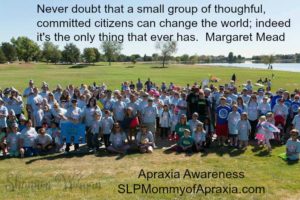It’s rare, so no one cares? Prevalence of CAS
What’s that?
If you have a child with CAS (Childhood Apraxia of Speech), you have heard this question once, twice, many, numerous, too many times to count in the course of their life. We all have developed our standard answer since we are prepared for the fact that no one knows what apraxia is. This sadly does not just include the general public. We run into this with doctors, teachers, professionals, and yes, some parents have even reported getting this question from Speech/Language Pathologists!
I am a self-declared Apraxia Advocate and the reason I’m so passionate about awareness is because with awareness comes proper diagnosis, and only after a proper diagnosis can the child get proper treatment. Only with proper diagnosis will we understand additional learning difficulties that may arise from this disorder; which means we will be better equipped to understand how they learn differently and tailor their educational programming better to fit their needs.
We say that CAS is a rare and severe speech disorder. We convince ourselves people don’t know about apraxia because it’s so rare, and sometimes, I think we all start to accept nothing will change. Afterall, it only affects 1-2 children in every 1000.
I certainly have my down moments where I have thought this, but it actually has never deterred me or stopped me from my efforts. I’m preparing for a presentation in July for the CASANA conference, and something made me look up prevalence rates of other disorders.
Have you ever heard of Down Syndrome? Are you reading this thinking what a silly question? I’m willing to bet 99% of you have heard of it. It’s covered well in graduate school for speech, and usually every school setting has at least one child with DS in the building. At the very least, most teachers, educators, professionals, and most of all therapists have heard of Down Syndrome.
Would it surprise you then if I told you the prevalence rates for Down Syndrome are 1-2 children in every 1000 births. Sound familiar? Maybe that’s just because I just wrote that figure for CAS.
I actually started to get worked up. Wait a minute. What is wrong with this picture? That can’t actually be right can it? I thought to my own personal experiences. At one school building I have two kids with DS and in a second, I have one. At one school building I have two kids with apraxia, and at another I have two as well.
Wait, so how is it EVERYONE it seems has heard of Down Syndrome, but no one ever seems to know what apraxia is? Oh friends, this bit of data has now only strengthened my resolve. At one point, somewhere, I’m sure Down Syndrome was a rare disorder too that no one had heard of. Oh friends, we need to step up our game. We need to stop accepting that no one will ever know or care about apraxia (oh fess up! I know we’ve all been there at some point). The it’s rare so no one cares attitude is not acceptable anymore.
We have to continue on! I saw this the other day and absolutely loved it. I can tell you I know many apraxia walk coordinators nationwide now and we all have this in common. Every person counts. Even one more person who knows what apraxia is, is a victory.
Let’s stop thinking rare=unknown, because it’s not true. We only need to look at the Down Syndrome Community to prove that point.
It’s time to make our collective voices louder. Join your local walk, educate the community around your child; remember, every person counts. CAS was only accepted as a real and distinct disorder in 2007, which really wasn’t that long ago….but the point to remember is that it IS a real and distinct disorder and our children DESERVE to have professionals in their life who are as familiar with apraxia as they are with Down Syndrome, don’t you think?
